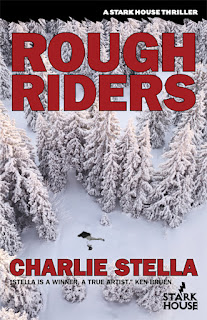Where full disclosure is warranted, I will . . . McCammon is
one of my top 2 or 3 favorite authors and I am unlikely to find fault with
anything he produces.
A couple weeks ago, McCammon’s website noted that Mystery
Walk (copyright 1983) for the Kindle was on sale for something like $2 through
Amazon. Having won a silent auction of beach supplies, including a Kindle, I
decided this might be a good title for my first experience at using an eReader.
Mystery Walk follows two markedly different boys over about
10 years, mostly in rural northern Alabama in the 1960s. Billy Creekmore is the son of a local resident
of Hawthorne and his wife, a Choctaw Indian. Ramona comes from a lineage of
healers whose special gift is to absorb the pain of people who died suddenly so
that their spirit can transition to the next world. The spirit of a person who
is unprepared for death lingers on earth in search of help. When a disturbed
vet kills his family and himself, the town shuns the street of the death house.
All the bodies were found except the son. One afternoon, young Billy is walking
home from school and is strangely drawn to the house, then into the kill rooms,
and finally to the basement where he sees a revenant trying to crawl out from
under a pile of coal. Billy stays a second and then dashes out, terrified after
seeing what he thought was his friend.
From this first experience with the dead, and the fear that
surrounds the town, Billy and his mom head off to see his grandmother for his
first introduction in his unique gifts and learn more about what he will face –
his Mystery Walk.
JJ Falconer runs perhaps the most successful evangelical
crusade in the south. When young Wayne was about 8 or so, a car critically
mangled his dog. Little Wayne ran out and scooped up his dog, hugging it close
and praying for God to help his dog. Within minutes, the dog’s injuries are
lessening and the dog begins to recover. Witnessing this miracle, JJ realizes
Little Wayne Falconer has the healing gift and starts to promote him as part of
his crusade.
At a tent revival near Hawthorne, the paths of Billy and
Wayne cross for the first time. Billy sees the black mist around a couple of
locals even after being told by Little Wayne that they had been healed; the
black mist indicates imminent death. Ramona has seen the mist too and shouts
out that by telling people to stop with their meds, that the crusade was
promoting murder. Needless to say, Ramona is now a pariah amongst the Hawthorn locals
who live for the Crusade.
JJ is convinced that Ramona and her son are evil doing
Satan’s work and does everything he can to keep Little Wayne safe. Billy is
just trying to figure himself out.
From here, the story follows Wayne and Billy (Billy mostly) throughout
their teen years. Wayne is healing and Billy is helping spirits of the suddenly
dead move on. But each sees a similar dream of an eagle in mortal combat with a
snake of fire. And Billy encounters the mysterious shape changer tempting him
as he wanders his personal wilderness.
JJ dies and Wayne is guilt-ridden that he was unable to heal
his father. Wayne is now in charge of a multimillion dollar enterprise, and no
where mature enough to be the head. In his nightmares, JJ comes to Wayne,
telling him that the Indian bitch and her son must burn in the fires of hell
for Wayne to be free.
Wayne catches the eye of a Palm Springs-based financier who makes
Howie Mandel’s germophobia behavior look like a mild tic. The obese Jabba the
Hut wannabe becomes Wayne’s defacto father-Svengali figure, keeping him drugged
and confined to be a personal healer to the mogul. To win Wayne’s devotion, and
sort of fulfill the wishes of JJ’s ghost, our corporate raider tasks his people
to (1) take over the crusade and (2) get rid of Wayne’s tormentors.
This classic battle of good vs. evil expertly combines
Indian mysticism with religion and images of the devil vs. spirit of all that
breathes. It also explores nature vs. nurture in the paths taken, and thrust
upon, Billy and Wayne as each takes their own version of a Mystery Walk. Not
the typical good guys vs. the bad guys, life is black and white in a gray
world, pile up the bodies and don’t look back kind of fare so typical of MRB.
While some of our favs have a real knack for clever, witty, dialogue amongst
the characters (e.g., Stella, Higgins, Bruen, Crais, Connelly, Pelecanos, et
al.), McCammon’s eloquent prose presents a lyrical image that unfolds akin to
looking at a detailed, but not overpowering painting or photograph. Because of
the genre of his earlier works (supernatural thrillers), he was unfairly compared
to Stephen King, but never acquired King’s mass-market appeal. With all the
fascination with vampires and the undead today, one would think folks would
discover They Thirst, Swan Song, or maybe Stinger or The Wolf’s Hour. For me, McCammon
presents skillful writing and escape at its best at every opportunity. And it
only gets better in his Matthew Corbett series set in the early 1700’s New
York, where I currently explore via my Kindle.
East Coast Don
 Can't quite remember the source of the suggestion to reserve this from the library. MRB's friend behind the Temporary Knucksline? I've been on the wait list for what seems like months. I'll summarize in 3 words: worth the wait.
Can't quite remember the source of the suggestion to reserve this from the library. MRB's friend behind the Temporary Knucksline? I've been on the wait list for what seems like months. I'll summarize in 3 words: worth the wait.










